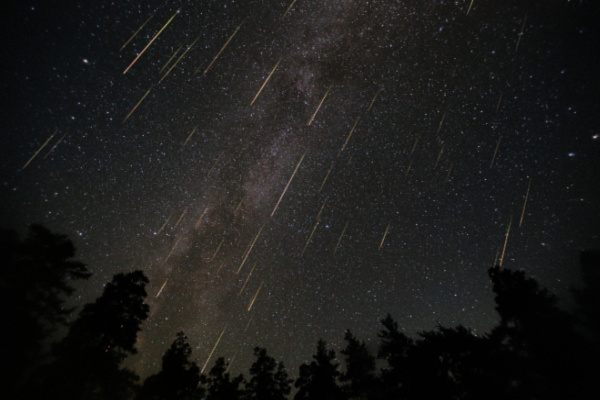October will be a good month for weekend stargazers as each weekend will feature a different astronomical event, ranging from meteor showers to two types of eclipses. The cool and crisp autumn weather will mean skywatchers and night owls may need to dig out hoodies and heavy coats from the closet before spending time outside soaking in views of the cosmos.
From a ring of fire to a flurry of shooting stars, AccuWeather brings you the astronomy events in October that you won’t want to miss.
Oct. 8-9: Draconid meteor shower
The first full weekend of October will conclude with the Draconids, a meteor shower that is predicted to peak after sunset on Sunday, Oct. 8.
The early-October event brings only about 10 meteors per hour, but it is an oddity, as it peaks in the evening hours rather than late at night like many other meteor showers, according to EarthSky. With the peak activity expected shortly after nightfall, people won’t have to lose much sleep while outside hoping to make a wish on a shooting star.
The Draconids occasionally flare into meteor storms, and one happened as recently as 2018 when onlookers counted more than 100 shooting stars per hour. In 2011, an even more impressive meteor storm unfolded with as many as 600 meteors per hour. However, such an outburst is not anticipated this year.
Oct. 14: ‘Ring of fire’ solar eclipse
The sun, moon and Earth will align on Saturday, Oct. 14, to create a solar eclipse that will be visible across part of North America.
Unlike a total solar eclipse when the moon completely blocks out the sun, the upcoming event will be an annular solar eclipse, with the moon not entirely appearing big enough in the sky to cover the face of the sun. The result is a halo of sunlight around the moon, giving the event the nickname of a “ring of fire” eclipse.
It is dangerous to look at the sun without the proper eye protection, so anyone hoping to see the event will need a solar filter or pair of eclipse glasses, along with favorable weather. The so-called “ring of fire” will be visible along only a narrow zone stretching from southern Oregon through southern Texas. Much of the rest of North America will experience a partial solar eclipse.
This will be a preview for an even more impressive total solar eclipse that will take place over the central and eastern United States, as well as portions of Mexico and Canada, on April 8, 2024.
Oct. 20-21: Orionid meteor shower
Less than two weeks after the Draconids peak, stargazers will have the chance to watch another meteor shower. The Orionids will treat onlookers to about 20 shooting stars per hour on the night of Friday, Oct. 20, into the early morning of Saturday, Oct. 21, weather permitting.
Meteors will appear to originate from the same area of the sky as the constellation Orion, which serves as the namesake for the annual meteor shower. Some meteors may begin to appear in the evening, with hourly rates gradually increasing as the night progresses.
Oct. 28: Hunter’s Moon eclipse
A full moon will fill the night sky during the final weekend of October, although for part of the world it will not be quite as bright as a normal full moon.
A partial lunar eclipse will unfold as the moon passes through part of Earth’s shadow. The eclipse will be best seen from Europe, Africa and Asia, while people across North America largely miss out on the show. The next partial lunar eclipse that will be visible for most of the United States will take place on Sept. 18, 2024.
October’s full moon is commonly referred to as the Hunter’s Moon, as it is the time of year when hunters prepare for the winter months. Other nicknames for the month’s full moon include the Falling Leaves Moon, the Freezing Moon and the Migration Moon.
—
Photo Credit: Makarov Konstantin / Shutterstock.com
